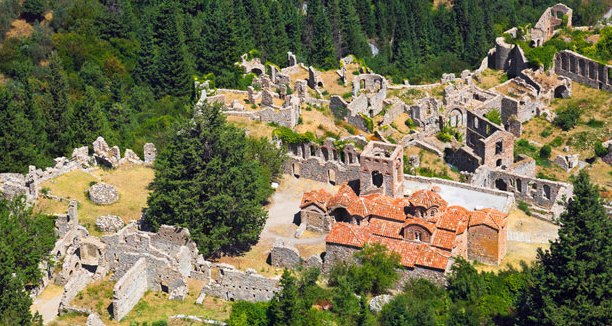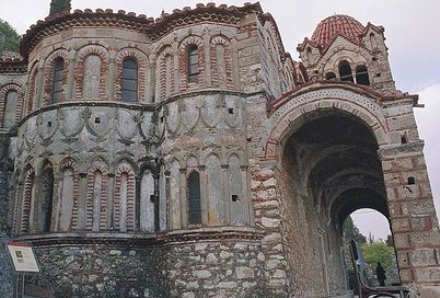
Mystras, located near Sparta in Peloponnese, constituted the steep fortress that Mount Taygetos offered to the last defenders of the more-than-thousand-year Byzantine Empire. Seven brilliant examples of ecclesiastical architecture and Byzantine art are saved today in the citadel, which is accessible to visitors.
Saint Demetrios Cathedral
Near the entry of the archaeological site lies Saint Demetrio, the cathedral of Mystras. Most probably built in 1291-1292, it initially had the form of three-aisled basilica, but later it was transformed to a cruciform with five domes. This transformation has its explanation; basilicas resemble the architecture of the first centuries of the Roman Empire and are directly related to Classical Greek buildings; on the contrary, the domed cruciform churches are associated with the look and spirit of Constantinople.
Monasteries
In Mystras, similarly to Constantinople and Thessalonica, there were monasteries within the walls.
Pantanassa monastery
Pantanassa monastery is the only monastery in Mystras still in operation today, with hospitable nuns ready to provide the visitors with benedictions, cool water and information.

The Catholicon of the convent, the church of Pantanassa (“Queen of All”), is the last big Byzantine era ecclesiastical work of Mystras. Founded in 1428 by Ioannes Francopoulos, scion of a prominent Constantinopolitan family, it represents every architectural trend and experimentation of its era, resulting in a most interesting work. Especially, the interior is a great discovery for visitors.
Color overruns everything: the women’s gallery, the arch of the sanctuary, the domes, the pillars and even the floor that is made of colorful marbles. Enumerating the frescoes is impossible. Apart from those in the ground floor, dated back to the 17th century, every fresco of the church is an expression of the general artistic tradition of the Palaeologan era.
The painters of Pantanassa vividly depicted their frescoes, so that the people in them move with elan and grace.
Brontochion
During the period of Mystras’s prosperity , Brontochion was a centre of intense intellectual movement. Here served as a teacher the biggest intellectual figure of the late Byzantine period, the neoplatonic philosopher Georgius Gemistus or Pletho, with a circle of eminent students, such as the later Roman Catholic cardinal Bessarion and the last historian of the Eastern Roman Empire Laonikos Chalkokondyles. Pletho founded here in Mystra a secret fraternity, where he taught a theory inspired by Platonism extolling the revival of a purified paganism.
Emperors and nobles competed in their offers to the monastery, resulting in its accumulated wealth and strength, but also one of the most important libraries of the Empire.
Inside the monasterial complex of Brontochion lie the two most impressive churches of Mystras:
Saint Theodores
The church was established in about 1290 by hegumen Pachomios and is adorned by a characteristic and reknowned octagonal dome. In the following centuries, the dome collapsed and Saint Theodores was deserted, until it was restored again in the 20th century. Because of the abandonment, the frescoes that were saved are few, but they are still distinguished for their technique. The two military saints depicted must have belonged to an entire “battalion” of armed saints that adorned the lower part of the walls, in the height of the faithful, preparing them for the consequences of those troubled times.
Above the pillars of the church, an angel moving rapidly offers a lilly in an Annunciation scene, while in the chapel where the tomb of Emperor Manuel Palaiologos lies he is depicted kneeling before the Infant-holder Theotokos.
Panagia Hodegetria (or Theotokos the Guide)
It is the second church in Brontochion founded in 1310 by chancellor Pachomios. The desire of the founder to imitate the patterns of large churches of Constantinople is clearly manifested in its design. Constantinople was experiencing hard times, politically being on its last legs. However, she still had an unsurpassed splendor in the domain of arts and humanities.
Hodegetria was the first church in Mystras, where the composite architectural style was applied: a three-aisled basilica in the ground plan and a cruciform with five domes and a narthex. We could say a lot more about the architecture of the church, if it was not overshadowed by its frescoes.
For the unique murals adorning the church, artists were called from Constantinople, to give an unworldly look to the figures portrayed. The visitor needs only to stand in front of the depicted martyrs on the western wall of the northern chapel, in order to feel the Byzantine magnificence: hovering forms with looks of deep spirituality, classic proportions and light movements, painting ability with an absolute perception of the colors and control of the nuances in an almost impressionistic finishing. This is a work of art, that the Oriental oppressor could never imagine or appreciate. The whole church is a huge canvas full of color contrasts and melodies.
In the chapel located in the northwest corner is buried Theodore II Paleologos, which probably led to the moniker “Prince’s church”, while the chapel in the southwest corner bears paintings of the golden-sealed imperial documents that provided privileges to Brontochion.
Peribleptos
The secluded church of Theotokos Peribleptos, founded in the 14th century, rests on the natural bedrock of Mystras, which is to blame for its architecturally irregular shape. Even so, the exterior of the church is distinguished for its elegant proportions and elaborate masonry.
In several parts, the church bears heraldic symbols: Lions and lilies, which were symbols of both Kantakouzenos and de Lusignan dynasties. We must not forget that the first wife of Despot of Mystras, Manuel Kantakouzenos, was Isabella de Lusignan.
Here the visitor can admire some of the most beautiful frescoes of Byzantine Art. Where should we look first? The sanctuary apse, where the Divine Liturgy is pictured with Christ officiating among snowy angels who hold the Holy Gifts? The sactuary arch, where Christ hovers between four angels, while Theotokos and the Apostles are staring in awe? The Nativity painting? The Baptism? Blessed are they who manage to closely look these unique pieces of art.
Hagia Sophia
In the district of the palaces, the Upper Town of Mystras, we meet Hagia Sophia, founded in 1365 as the Catholicon of a big monastery, identified by many as the Life-Giver Christ’s. On the column capitals, one can discern the monogram of its founder: Manuel Kantakouzenos Palaiologos Despot Founder. It architecturally belongs to the two-columned type, a variant of the domed cruciform, while a tall three-storey bell tower stands next to it.
Although being a monasterial Catholicon, the church must have served the neighboring palace, as the Cathedral is quite far away from this administrative complex.
During the extensive restoration work of the past decade that resulted in the good condition of the church, unknown aspects of the monastery life were discovered, such as the water supply through underground clay pipes.
Among the church paintings, the most distinguishable is the Nativity of the Theotokos and a procession of women in costumes of the nobility of Mystras offering gifts.






